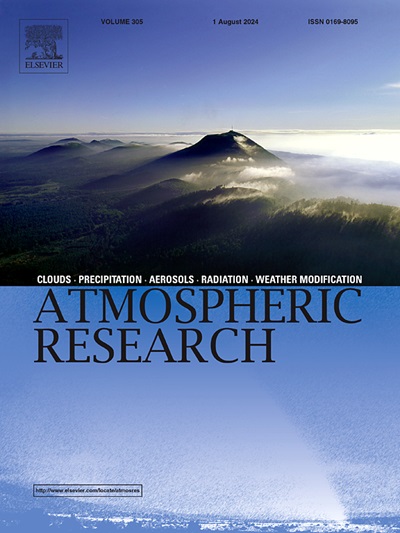Assessment of non-parametric method for evapotranspiration estimation across extreme conditions
IF 4.4
2区 地球科学
Q1 METEOROLOGY & ATMOSPHERIC SCIENCES
引用次数: 0
Abstract
Terrestrial evapotranspiration (ET) estimation faces constraint due to complicate parameterization. The non-parametric (NP) method offers an efficient alternative, but its effectiveness across diverse environments, particularly under extreme conditions, is uncertain. This study leverages data from 131 global flux stations across various climate and landcover types to assess the NP method's accuracy, focusing on extreme scenarios spanning from dry to wet and from hot to cold. Our results indicate substantial variability, with absolute errors ranging from −41.7 to 26.8 W/m2 and relative errors between 0.4 % and 98.1 %. The NP method tends to overestimate ET in hot, dry conditions, and underestimate in cold, wet conditions, with performance declining under extremes. Cold climates exhibit the largest biases, with particularly severe underestimation in extreme wet (−54.5 W/m2) and cold (−69.2 W/m2) conditions. Closed shrublands demonstrate the largest overestimation (73.2 W/m2) in extreme hot conditions. Across stations, three error patterns are observed: (i) overestimation in dry-hot regions caused by a high difference between equilibrium and actual ET, (ii) underestimation in humid regions resulting from a low difference, and (iii) underestimation in cold regions arising from large surface-air temperature gradients, causing an excessive integral term resulting in overcorrection. These errors could be amplified under extreme conditions, reducing model performance and highlighting the NP method's sensitivity to hydroclimatic extremes while offering insights for improving its accuracy and robustness.
极端条件下蒸散发估算非参数方法的评价
地表蒸散发估算由于参数化的复杂性而受到限制。非参数(NP)方法提供了一种有效的替代方法,但其在不同环境下的有效性,特别是在极端条件下,是不确定的。本研究利用来自131个全球通量站的数据,涵盖各种气候和土地覆盖类型,以评估NP方法的准确性,重点关注从干到湿、从热到冷的极端情景。我们的研究结果显示了很大的变异性,绝对误差在- 41.7到26.8 W/m2之间,相对误差在0.4%到98.1%之间。NP方法倾向于高估炎热、干燥条件下的ET,而低估寒冷、潮湿条件下的ET,在极端情况下性能下降。寒冷气候表现出最大的偏差,在极端潮湿(- 54.5 W/m2)和寒冷(- 69.2 W/m2)条件下的低估尤为严重。在极端炎热的条件下,封闭的灌丛表现出最大的高估(73.2 W/m2)。在各个站中,观测到三种误差模式:(i)由于平衡ET与实际ET之间的高差异而在干热地区高估,(ii)由于低差异而在潮湿地区低估,以及(iii)由于地表-空气温度梯度大而在寒冷地区低估,导致积分项过大而导致过校正。在极端条件下,这些误差可能会被放大,从而降低模型性能,突出NP方法对极端水文气候的敏感性,同时为提高其准确性和鲁棒性提供见解。
本文章由计算机程序翻译,如有差异,请以英文原文为准。
求助全文
约1分钟内获得全文
求助全文
来源期刊

Atmospheric Research
地学-气象与大气科学
CiteScore
9.40
自引率
10.90%
发文量
460
审稿时长
47 days
期刊介绍:
The journal publishes scientific papers (research papers, review articles, letters and notes) dealing with the part of the atmosphere where meteorological events occur. Attention is given to all processes extending from the earth surface to the tropopause, but special emphasis continues to be devoted to the physics of clouds, mesoscale meteorology and air pollution, i.e. atmospheric aerosols; microphysical processes; cloud dynamics and thermodynamics; numerical simulation, climatology, climate change and weather modification.
 求助内容:
求助内容: 应助结果提醒方式:
应助结果提醒方式:


